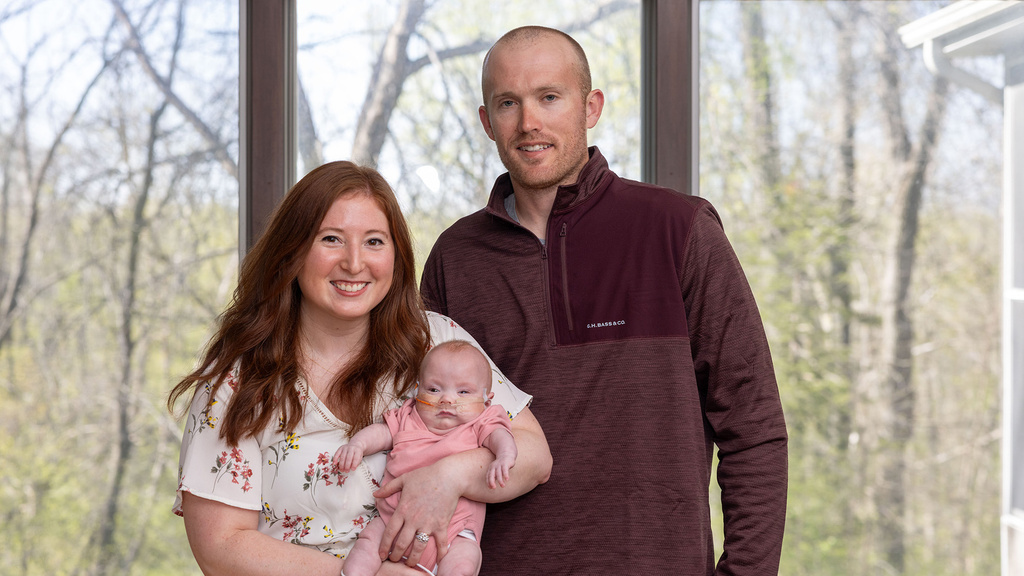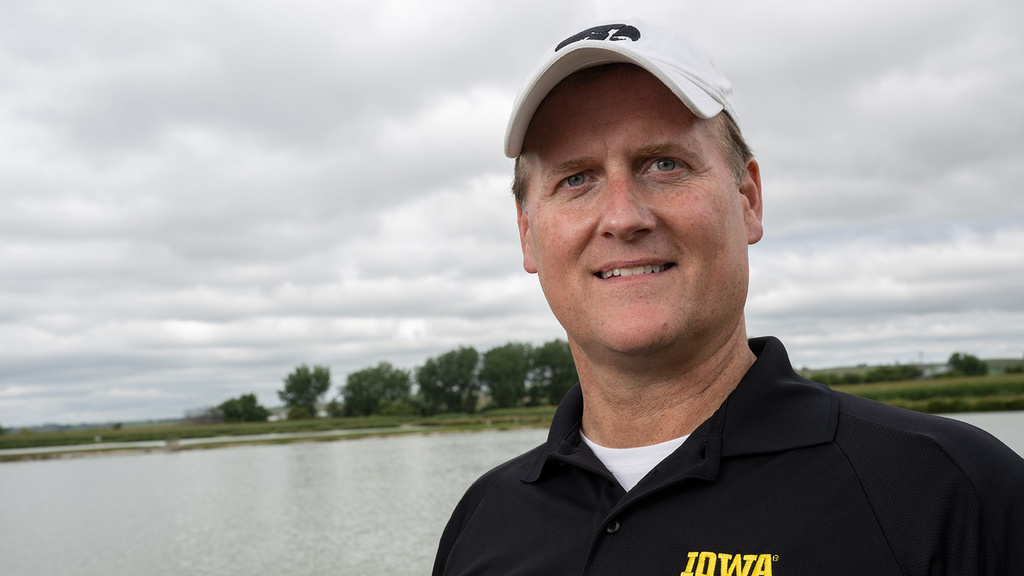More than one in 10 Americans have diabetes, a chronic condition in which the body cannot effectively process blood sugar, and diagnoses are increasing around the world. Why? University of Iowa researchers are working to find answers — and improve the lives of those with the demanding disease.
Story: Sara Epstein Moninger
Photography and videography: Justin Torner
Published: March 9, 2021
The top images...
Daniel Ivory, and his 11-year-old daughter, Lydia, both have been diagnosed with diabetes (Daniel has Type 2; Lydia has Type 1), and both receive care at University of Iowa Health Care. “The advances that have been made since I was diagnosed [in 2004] are just tremendous,” Daniel says. “Those absolutely have to continue.”
If Liv Schaller could live one day without diabetes, the 13-year-old wouldn’t run out and order a cheeseburger with fries at the nearest fast-food restaurant. Nor would she scarf down a pint of ice cream.
Nope. Instead of indulging in forbidden high-carb foods, she would simply enjoy a day without worry. A day without checking her blood sugar. A day without counting carbs. A day without carefully planning her food intake and injecting insulin before each meal.
At age 6, Liv was diagnosed with Type 1 diabetes, in which the immune system attacks the insulin-producing cells in the pancreas. Without insulin, the body is unable to take up glucose and use it for energy, leading to excessive breakdown of fat and muscle and a potentially dangerous condition called ketoacidosis.
Ever since her diagnosis in 2013, Liv has traveled from her home in Carthage, Illinois, to Iowa City every three months to receive care at University of Iowa Health Care Stead Family Children’s Hospital. She totes insulin, needles, and a glucometer everywhere she goes. As a person with Type 1 diabetes, she requires frequent injections of insulin to stay alive.
The cumbersome routine of checking her blood sugar, counting carbohydrates, and measuring insulin is the easy part, Liv says. In fact, advances in technology now allow her to wear an insulin pump and a continuous glucose monitor, small devices that make it even easier to follow her blood sugar levels and administer insulin. But they don’t take away the stress of having the disease, one she will have for the rest of her life.
“I think people would be surprised to learn about the mental strain of having diabetes. It’s not just physical,” says Liv, an eighth grader who likes science and math, hanging out with friends, and making earrings. “I would just love to not have to think about it all the time.”
Searching for answers
Doctors and scientists at the University of Iowa are working to bring this peace of mind to Liv and improve the lives of the estimated 463 million people worldwide with Type 1 and Type 2 diabetes. The imperative is clear: sustained high blood sugar can lead to serious health issues such as heart and kidney disease, blindness, nerve damage, limb amputation, and even death.

“I would just love to not have to think about it all the time,” says Liv Schaller, 13, who was diagnosed with Type 1 diabetes at age 6. (Photo courtesy of the Schaller family.)
At the university’s internationally respected Fraternal Order of Eagles Diabetes Research Center, more than 90 investigators seek answers on what causes the disease and potential new treatments. A $25 million gift commitment from the Fraternal Order of Eagles in 2008 provided the catalyst needed to coordinate existing diabetes-related research on the UI Health Care campus, recruit top researchers, and boost innovative new studies into the disease and its complications.
The university established the Fraternal Order of Eagles Diabetes Research Center with dedicated office and lab space in the Pappajohn Biomedical Discovery Building, a campus facility where interdisciplinary teams work on pressing health issues. They conduct research in a variety of disciplines, including internal medicine, ophthalmology, physical therapy and rehabilitation science, health and human physiology, neuroscience, chemistry, biomedical engineering, economics, biology, psychological and brain sciences, and computer science.
“We have assembled at Iowa one of the deepest and strongest benches in the world in the area of diabetes research,” says E. Dale Abel, director of the center. “The work we are doing really runs the gamut — and we’re busy.”
The struggle to adjust
In 2004, Daniel Ivory was putting in long hours at a post office job to support his family of five while also investing time and money to open a drive-thru coffee shop in Clinton, Iowa. Shortly thereafter, he found out his pregnant wife had a life-threatening blood clot. A diagnosis of Type 2 diabetes seemed to pile on.
It was a stressful time in Ivory’s life. Although he immediately began a regimen of insulin and oral medications, he didn’t take care of himself. It was a challenge every day not to reach for the salty and crunchy snack foods he craved—and he often wasn’t successful. Making matters worse, a bridge adjacent to the coffee shop closed, cutting off customers, and he ultimately had to close the business. When he later took a factory job, he found it wasn’t convenient to periodically step away and check his blood sugar. So he didn’t.
“For years, I was basically living on sugar and caffeine. I remember not wanting to think about my health because there was so much other stuff going on, and I didn’t actually want to make the life adjustments I needed to make,” says Ivory, who had no family history of diabetes. “Not only was my blood sugar out of control, I was keeping everything to myself. I think the stress exacerbated the diabetes.”
What is diabetes?
Diabetes is a chronic disease in which the body is unable to effectively process blood sugar. Insulin is a hormone secreted by the pancreas that removes sugar from the blood and stores it in muscle, fat, and liver cells. In Type 1, there is an insulin deficiency due to autoimmune destruction of insulin-producing cells in the pancreas; in Type 2, the more common form of the disease, there is insulin resistance in combination with progressive failure of insulin-producing cells to compensate.
Both types appear to be linked to genetics, and lifestyle and environmental factors may also play a role in both. Some women develop diabetes during pregnancy, which puts them at increased risk for developing Type 2 diabetes postpartum. People with Type 1 diabetes must inject insulin to live. Type 2 often can be controlled with diet and exercise, and sometimes may be treated with medications or insulin injections.
Inadequately treated diabetes can lead to major health complications, such as heart and kidney failure, stroke, limb amputation, blindness, chronic pain, and death.

Daniel Ivory and his daughter Lydia both receive care at University of Iowa Health Care, and both wear continuous glucose monitors, unobtrusive devices that share blood sugar data via Bluetooth every five minutes — some 288 readings per day. “This device has been a game-changer,” Daniel says.
Ivory’s wife survived, and the couple now has six children and three grandchildren. He is enrolled in an online baccalaureate program in business administration. While he still wrestles with food cravings, Ivory has learned to identify his triggers for unhealthy eating. As a result, his A1c — a blood test that measures average blood sugar over the previous three months — has gone from 11.5 to 7.4, just above the desired goal of 7.0.
“The low-carb diet has been a huge adjustment. I love to cook. I love every kind of food out there. Diabetics have to be so intentional about what they’re eating, and that’s challenging because all the foods that are bad for them are easy, quick, and everywhere,” he says. “It’s taken me a really long time to get my head wrapped around this disease. I’ve learned that being angry and depressed is not productive. Taking control is much more empowering. It’s not easy, but I am learning how to do it.”
Ivory credits two developments for helping him manage the disease: advances in technology and a new family diagnosis.
“You can put it aside when it happens to you, but not when it happens to one of your children,” says Ivory, noting that his 11-year-old daughter, Lydia, was diagnosed with Type 1 diabetes in 2020. “That made diabetes more real for me. When it happens to somebody you love, someone you’re responsible for, that’s a completely different realm.”
Ivory and his daughter both receive care at University of Iowa Health Care, and both wear continuous glucose monitors, unobtrusive devices that share blood sugar data via Bluetooth every five minutes — some 288 readings per day. “This device has been a game changer,” he says. “All I’ve got to do is tap the screen of my phone and I know exactly what my blood sugar is — and whether it’s going up or down. There’s also an alarm if my blood sugar gets too high or too low. The advances that have been made since I was diagnosed are just tremendous. Those absolutely have to continue.”
Inside the research center
As leader of the Fraternal Order of Eagles Diabetes Research Center, Abel works to usher in advances that could benefit people with diabetes like Ivory. Internationally recognized for probing the link between diabetes and heart disease, Abel studied medicine at the University of the West Indies in Jamaica, traveled to Oxford University as a Rhodes Scholar, and conducted research at Harvard University and the University of Utah. Iowa intrigued him.
“When I visited Iowa City, I saw that there was already a basic core of researchers on campus that could form the nidus of something bigger, and the environment was incredibly collegial,” he says. “Not only did people seem to be very generous, they had a strong desire to rally around a compelling vision. That motivated me to take the leap.”
Since Abel took the reins in 2013, the center has recruited 27 investigators to Iowa and supported 29 research proposals from faculty across campus through a pilot grant program. Studies in the center are wide-ranging. Examples include investigating how altered metabolism in muscle, liver, and fat cells contributes to obesity and diabetes; deciphering mechanisms for appetite regulation; exploring why insulin-producing beta cells fail; developing better testing to identify Type 1 diabetes risk; identifying new biomarkers for gestational diabetes; and understanding how mitochondrial dysfunction can lead to diabetic complications such as heart failure or nerve damage. The center also has become a major hub for training the next generation of diabetes researchers from around the world.
“We have already received new funding in excess of the gift that started the center,” Abel says. “So not only is the return on investment high, but I think we are likely to make discoveries that will significantly advance our understanding of both the pathogenesis of diabetes and its complications, and that will lead to new therapies.”
Investigators already are making exciting discoveries. In 2020 alone, a study in Abel’s lab suggested that the high-fat, low-carb ketogenic diet mitigates heart failure, a leading cause of death in people with Type 2 diabetes, while a team working with Abel and UI geneticist Val Sheffield discovered that exposure to electromagnetic fields may be a safe and noninvasive way to manage blood sugar. In neuroscience and pharmacology, Matthew Potthoff and his team learned that a liver hormone promotes weight loss by signaling to the brain to reduce sugar intake, and they are using that knowledge to develop new treatments for obesity and obesity-related diseases like Type 2 diabetes.
Many new studies have similar potential, whether by examining environmental factors that contribute to diabetes risk, or finding out how diabetes alters muscle gene expression and leads to muscle atrophy, or learning more about how activating an integrated stress response in brown fat cells can increase metabolism.
Andrew Norris, a pediatric endocrinologist at UI Health Care Stead Family Children’s Hospital, studies Type 2, gestational, and cystic fibrosis–related diabetes. He has seen significant achievements in diabetes treatment during his medical career, including improved insulin pumps, more effective insulins, and continuous glucose monitoring. In fact, research by two of his UI colleagues in pediatric endocrinology, Eva Tsalikian and Michael Tansey, helped drive the clinical application of continuous glucose monitoring devices like the ones the Ivorys use.
Did you know?
- Some 34 million Americans have diabetes (more than 10% of the population), with 1.5 million diagnosed every year and 88 million considered at risk.
- Diabetes was the seventh-leading cause of death in the United States in 2017.
- The national cost of diabetes in the U.S. in 2017 was more than $327 billion, up from $245 billion in 2012.
- Approximately 225,000 people in Iowa, or 9.3% of the adult population, have been diagnosed with diabetes; an additional 70,000 people in Iowa have diabetes but don’t know it, greatly increasing their health risk.
- There is no cure for diabetes.
Source: American Diabetes Association
Much more work remains, Norris says. Not only are incidence rates for both Type 1 and Type 2 diabetes increasing, Type 2 involves insulin resistance, a complicated condition of the disease that can negatively affect organ systems.
“We don’t have good medicines that cure or help insulin resistance,” he says. “In Type 1 diabetes, if you can control your blood sugars with insulin, you’ve taken care of the one problem you have. But we don’t yet have the tools to perfectly control blood sugar.”
Norris says the energy of his peers in the research center is “palpable.” Teams have benefited from $224 million in federal research funds, including a doubling of grants from the National Institute of Diabetes and Digestive and Kidney Diseases in the last year alone.
But competition for federal dollars is increasing, Abel says. To maintain momentum, he is searching for additional means to advance the center’s mission, including mining new funding sources and forming a robust collaboration with diabetes researchers at the University of Minnesota.
Abel is at once motivated and patient. His grandmother struggled with diabetes, and he lost a first cousin to the disease.
“Diabetes causes much suffering and expense, and it is not going away — in fact, it’s likely to get worse over time. There is a big imperative for us to understand how and why it happens,” he says. “While I’m encouraged by our progress, it’s a marathon and not a sprint. The more we learn, the more questions arise.”

Morgan Von Ahsen (left), who brings her daughter, Emerson, to UI Stead Family Children’s Hospital for diabetes care, says she feels confident that major advances will occur in Emerson’s lifetime — even at Iowa. She is encouraged by what she has witnessed during the four years since her daughter’s diagnosis. “I understand that patience is key, but I like to think that someday Emerson will get to live without diabetes. I don’t know if that will happen, but I’m not ready to give up hope that it will.” (Photo courtesy of the Von Ahsen family.)
The big impact of small advances
Emerson Von Ahsen grimaces slightly as her mother, Morgan, attaches an Omnipod insulin pump to her behind. One click and it’s over. The girl bounces up and down and assures those watching the YouTube video she is making that the process is quick and (mostly) painless.
“It’s gonna be OK,” she sings, “when I change my pump, OK?”
Emerson was diagnosed with Type 1 diabetes just days after her first birthday. Now the kindergartner from rural Williamsburg, Iowa, doesn’t know a life without the disease. Her mom and dad were just settling into life as parents when their routine was suddenly disrupted, their days punctuated by multiple insulin injections and blood sugar checks.
“We would check her blood sugar before she ate and give her insulin, and then two hours later we would recheck her sugar,” Morgan recalls. “We would set our alarm in the middle of the night, once at midnight and again around 3 a.m., and poke her little toe to check again. She always slept through it, which was the biggest blessing.”
Now Emerson wears an insulin pump and a continuous glucose monitor, allowing her parents to check her levels remotely. The disease still requires constant management, however, and Morgan trains Emerson’s teachers and day care providers every year. Emerson, for her part, is so unfazed by her treatment regimen that she decided to make video tutorials for kids who may be struggling with it.
Morgan, who brings Emerson to UI Stead Family Children’s Hospital for diabetes care, says she feels confident that major advances will occur in Emerson’s lifetime — even at Iowa. She stays up to date on recent developments and is encouraged by what she has witnessed during the four years since her daughter’s diagnosis.
“Some advances may seem small, but they can make a big difference. For example, when we first got a continuous glucose monitor, we still had to enter her blood sugar every 12 hours to keep it calibrated. She now wears the newest model, and I can’t remember the last time I poked her. I used to wake up in the middle of the night to poke her, and I don’t do that now,” Morgan says. “I understand that patience is key, but I like to think that someday Emerson will get to live without diabetes. I don’t know if that will happen, but I’m not ready to give up hope that it will.”
Abel says even if diabetes can’t ever fully be cured, his mission is to eradicate the disease—and the suffering it causes—as much as possible. He believes Iowa is well positioned to make that happen.
“There’s no question now that diabetes research is one of our institutional crown jewels, in terms of the depth and the breadth of what we are doing and the national and international reputation that we now have in the sphere of diabetes research,” he says. “Now we just need more space.”


